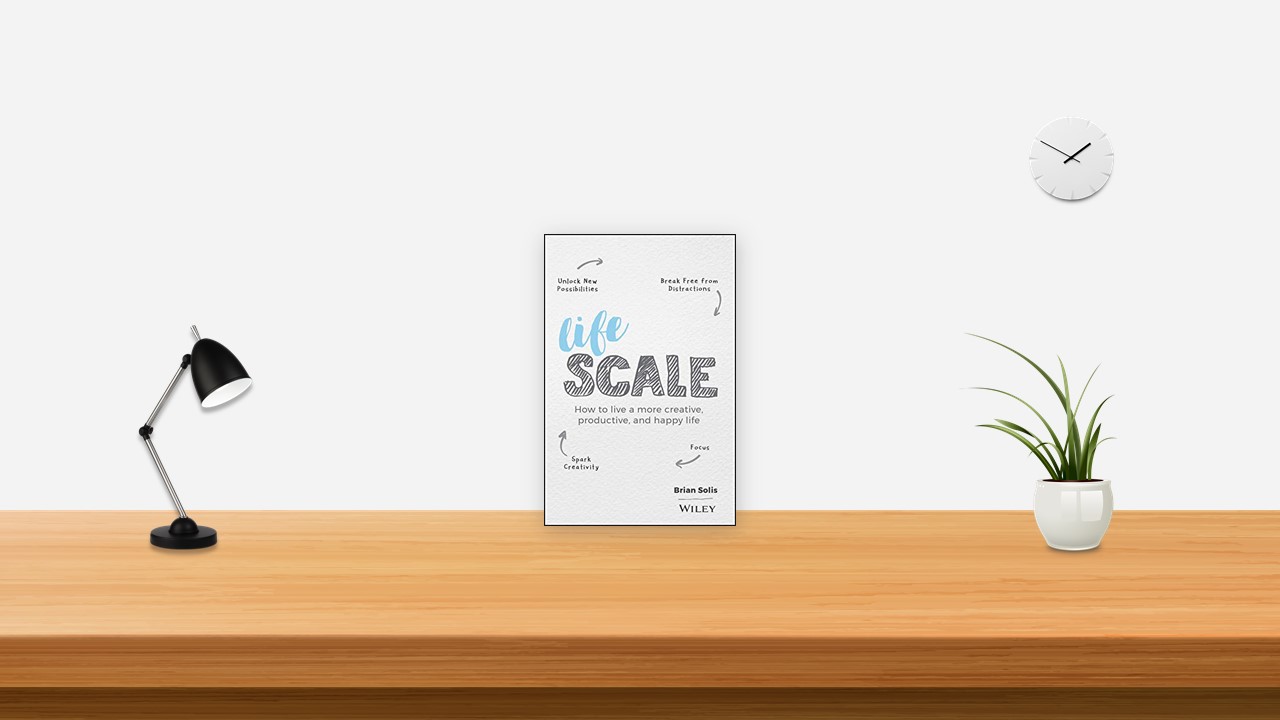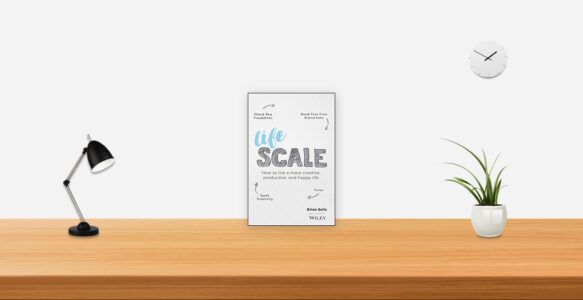Realize
Every day, we’re finding it harder to disconnect, if we’re trying to disconnect at all. Yet, every part of our lives is being disrupted. We’re suffering from thinning attention spans, reduced empathy, narrowed inputs for intellectual and creative guidance and inspiration, diminished capacity for critical thinking, deep focus and creativity.
We keep telling ourselves we’re fine—there’s nothing to see here folks! We’ll get to our hopes and dreams one day! But they seem to be gaining distance from us. We’re also not as happy or as creative as we could be. And, those two things are interlinked . . . happiness and creativity.
If ignorance is bliss, awareness is awakening.
The first step in lifescaling is coming to terms with why we’ve become so addicted to distraction. It’s certainly not entirely our fault—not by a long shot—but the truth is that we’ve been complicit. So let’s start by investigating why.
The Path to Distraction: How Did We Get Here?
Doing so many tasks at once leaves us with insufficient attentional energy to do any of them really well.
The corrosive effects of multitasking include
- Wastes time, attention, and energy—While you may manage to produce some output, productivity, engagement, and value are usually compromised. As
- Attacks output quality—Think you’re great at multitasking? Bravo! Reports show that working on two or more projects simultaneously takes longer than if you worked on each one individually
- Makes you mistake prone—From typos to unexplained lapses in logic, random errors appear in everything you produce, because you’re overwhelming the frontal cortex and not giving yourself enough depth and space for critical thinking
- Hinders intellectual and affective processes—One of the side effects of multitasking is skim reading. When the reading brain skims texts, “we don’t have time to grasp complexity, to understand another’s feelings or to perceive beauty,” according to Maryanne Wolf of UCLA
- Causes stress—When you are switching between tasks, you place yourself in a mode of high alert or on the edge. Your true creativity is not kindled. Instead, your heart rate is up, and you produce the stress hormone cortisol.
- Makes you miss out on life—If you’re multitasking, you’re missing out on many things on many fronts. Something as simple as walking and talking/texting/messaging makes you miss the beauty of your surroundings
- Affects your memory—Have you ever lost your train of thought or a common word in the middle of a story? Have you ever stood still and asked yourself, “What was I about to do?” Switching between tasks disrupts short-term memory
- Extinguishes creativity—Just like your laptop or tablet uses RAM (random access memory) to give you rapid working ability in your open tabs/windows, human multitasking uses working memory or temporary brain storage.
- Lowers IQ—Not only does multitasking slow you down; it lowers your IQ, according to research conducted by the University of London
- Leads to increased distractibility—You’ve been there many times. You’re working on something, you switch to check your streams, you see a link, you click it, and then 30 minutes later, you’re wondering what just happened to the last half hour.
- Hurts your relationships—At the most basic level, whether you’re with loved ones, friends, colleagues, managers, teachers, and so on, if you break moments of engagement to mindlessly multitask, your actions, maybe not your words, say, “I’m only partially in this moment right now with you.
Refocus
Working in sprints is a great way to begin to learn how to become distraction-free. Even this short sprint approach is not without its challenges, however. It may sound easy, but as you’ll experience, focusing for 25 distraction-free minutes or more demonstrates exactly why we’re going through this exercise.
You might have heard about the Pomodoro Technique. Inspired by the Pomodoro kitchen timer, this time management method was developed by Francesco Cirillo. It uses the timer, or in my case a mobile phone and desktop app, to break down workflows into approachable 25-minute sprints, separated by five-minute breaks
Here’s how the process works:
- Choose a task to be accomplished.
- Set the Pomodoro to 25 minutes.
- Work on the task until the Pomodoro rings, then put a check on your sheet of paper (or the app) related to the project.
- Take a five-minute break.
- After every four Pomodoros, take a longer break (usually between 15–30 minutes)
To begin, right now:
- Schedule time for one project tomorrow morning.
- Block out 25 minutes on your calendar.
- Tomorrow morning, hang the Do Not Disturb sign physically and digitally.
- Turn off notifications.
- Turn off your phone.
- Turn off email.
- Close all those tabs—you know what I’m talking about.
- Resist temptation to indulge in any diversion, regardless of how quick or seemingly harmless.
- Put on your headphones.
- Have refreshments at the ready.
- Use the restroom.
- Start the clock, and Focus.
Rekindle
No matter how young or old we are, we can all rekindle our most youthful, unfettered, joyful creativity. Age and creativity are not bound to one another. Creativity is like an age-defying elixir.
Start asking questions. Part of following the rules is to not question them. But if you remember, one of your favorite questions to ask was, “Why?” We were curious. We honestly wanted to know why something existed, why we did things certain ways, why people were the way they were, why we couldn’t do something, and so on. Asking questions should be just as important to us as adults. We should challenge ourselves all the time with exploratory questions such as “What if . . .” or “How can we . . . ?” Let your curiosity run wild.
Let yourself be silly. Be a kid again and schedule playtime. Find time to do some of the things kids do. Play in a playground. Fly a kite. Build a sandcastle. Play tag or hide and seek. Watch cartoons and read children’s books, even if you don’t have children. Smile. Laugh. Take yourself to Disneyland!
Who cares if you look weird?
- Shift positions from the impossible to seemingly possible. Banish the phrase we can’t and investigate the possibilities that seem improbable.
- List three ideas every day. Keep a running list of ideas you have each day, no matter how impossible, foolish, or grand. You don’t have to stop at three. If ideas are flowing, bring them on. Visit the list every day as you add your new items and consider which of them you might now move to your actual to-do list.
- Find creative project. You don’t have to have talent in whatever you choose. Just find an outlet for exercising the right side of your brain. Paint, draw, doodle, write poetry or a book manuscript, script, or screenplay, play an instrument, cook, take pictures, make movies, or all of the above! Just create, regularly.
- Express yourself in all you do. Buy the clothes you love, stylish or not, pursue the activities that interest you, no matter how odd or boring they may seem to others; share your thoughts, even if they’re contrarian or might seem wacky. Find your voice.
- Be courageous. Fearing risk or failure is the cancer of creativity, and taking chances is rocket fuel. The more chances you take, the more you learn, gain experience, and build confidence, and that becomes contagious!
As you have fun finding ways each day to rekindle your creativity, please join me on the next steps of the journey of lifescaling—reconnecting with your hopes and dreams, rediscovering what truly makes you happy, and crafting a clear understanding of your life purpose, that is, your purpose for this phase in the ongoing process of lifescaling.
Reorient
Thinking about ourselves is not the same as knowing ourselves. Often, we invest in the former, without ever getting to know who we really are and why. As such, we can’t envision who we need to be and how to get there.
Self-aware people are generally more positive thinkers. They are also more compassionate with themselves and others and they tend to act more consciously, rather than passively and reactively. This fosters psychological well-being, and more values-driven, purposeful living.
Yet most of us spend almost half our time in our day-to-day lives operating on automatic pilot. We’re unconscious of what we’re doing and feeling, as our mind wanders everywhere but the here and now, according to psychologists Matthew Killingsworth and Daniel T. Gilbert of Harvard.
Introspection about What Not Why.
We learned from an early age that if we want to understand things, we should ask why questions. Asking why is part of developing our sense of ourselves as independent people, beginning the process of understanding the way the world works.
Wanting to know why things are as they are is a sign of taking responsibility for making our way in the world. Unfortunately, when it comes to self-awareness, though, asking why works against us.
When we ask why, it doesn’t lead us to the truth about ourselves, it leads us away from it.” We get so caught up in looking backward, trying to establish a causal chain of events that have led us to where we are, that we’re not focusing on the possibilities of the present and how we can move forward. In other words, we get stuck in the egosystem.
Truly self-aware people share something interesting in common. They don’t ask why. Instead, they’re focused on what. They ask themselves questions like:
- “What’s important to me?”
- “What situations make me feel terrible and what do they have in common?”
- “What is my purpose in life, right now, and what will it take for me to fulfill it?


